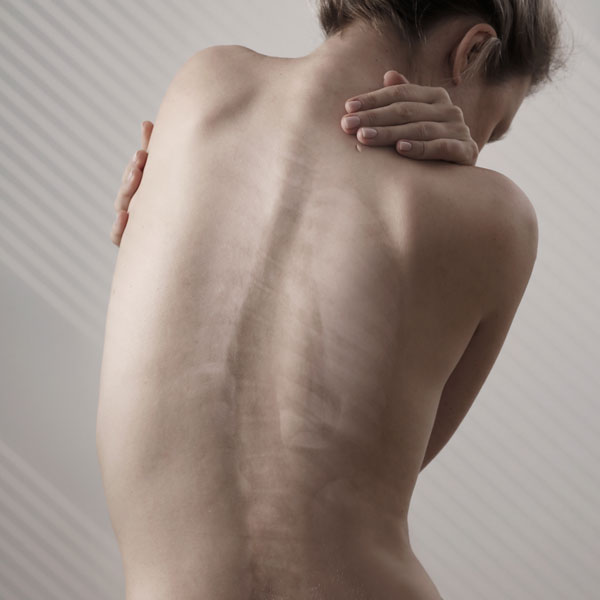The Reality of Living with a Curvature of the Spine

A diagnosis of scoliosis, or an abnormal curvature of the spine, affects each person’s life differently. Quality of life can vary significantly depending on the severity of the curve, an individual’s symptoms of scoliosis, how early interventions are implemented, and the quality of support or treatment. Today, we will dive into the realities of living with scoliosis, and what you can do to boost your overall sense of well-being in spite of your diagnosis.
Symptoms of Scoliosis
When it comes to managing symptoms associated with scoliosis, they will vary significantly depending on the severity of the spinal deformity, family history, and other individual factors. The most common secondary symptoms of scoliosis include back pain, poor movement mechanics, and breathing difficulties. These can be further exacerbated by other chronic health issues, poor mental health, and defective coping strategies for dealing with pain.
Luckily, most cases of scoliosis are considered mild in nature. Mild cases are most often associated with minimal or no symptoms. Thus, you can most likely manage any symptoms you are experiencing with conservative treatment options. Surgery, or other invasive treatments like injections, are reserved for less than 10% of cases that are considered severe and debilitating. This is good news since invasive treatment options, like spinal fusion, come with their own risks and side effects, such as chronic pain and loss of productivity.
Conservative Treatment and Support
The biggest concern with scoliosis is twofold: managing current symptoms and preventing further progression of the curvature. As noted above, unless they are severe, symptoms will most likely be manageable with simple lifestyle adjustments and noninvasive treatment. Research supports a few specific treatment options that can help you optimally manage your curvature and ultimately improve your ability to participate in your own life the way you want. Below are the top three supported options in the literature that yield promising results for managing scoliosis effectively.
Exercise
Contrary to traditional beliefs from a decade or two ago, it has been found that one of the best ways to manage a spinal curvature is to keep an active lifestyle. Consistent intentional movement helps promote optimal core muscle strength for supporting the spine, maintaining flexibility, boosting bone health, and better managing a healthy weight throughout life. Low impact exercise is always beneficial, such as swimming, yoga, and pilates. Yet, even more moderate and high impact exercises such as running and biking, are possible too and can boost your confidence in your own body. You can experiment and talk to your trusted healthcare professional for medical advice, including an orthopedic doctor, chiropractor, or physical therapist to decide what exercise options are best for you.
Exercise should play a pivotal role in living a healthy lifestyle, regardless of scoliosis. It’s also important to keep In mind that other lifestyle factors can help promote optimal spine health and an ideal weight too. These include eating a well-balanced diet, getting enough sleep, and proper stress management.
Physical Therapy
Working with a physical therapist (PT) will help you understand your body’s unique asymmetries. A personalized program can be developed to promote better spine balance, optimize posture, and learning better breathing techniques. Perhaps the best part of formal treatment with a PT is getting formal education to help you feel empowered in managing your scoliosis. The Schroth Method is one specific treatment option that is supported by research and utilized by PTs. A PT that is specialized in this method can help patients with adult or adolescent idiopathic scoliosis (meaning the cause is unknown) derotate, elongate, and stabilize the spine.
Chiropractic Care
Managing scoliosis with the guidance of a chiropractor is another excellent way to feel your best. After all, they are the experts in spine health and alignment. Chiropractic care typically employs a mixture of posture education, spine adjustments, core strengthening, and bracing. Science supported bracing, like the ScoliBrace, has been shown to prevent progression and, in some cases, even reverse mild curvatures that are flexible in nature. The ScoliBrace provides many specific benefits by providing adjustable and comfortable three dimensional spine support. It has been proven to significantly reduce the need for surgery and is high effectively for treating juvenile idiopathic scoliosis.
Talk to your local chiropractor about what options they offer for scoliosis. The Bay Area Scoliosis Center is specialized in providing top of the line treatment and support for all your spine needs. They can help you determine if their conservative treatment options and use of the ScoliBrace are a good fit for you. The first step is getting in touch with their expert staff.
Social and Emotional Support
Outside of physical anomalies, living with scoliosis can also have enormous social and emotional implications. Having a curvature of the spine can affect some individual’s, particularly developing children and adolescents, self-esteem and make them feel self conscious. First, it’s important to keep in mind that we tend to be overly critical of our own flaws, when others may not even notice. However, regardless of age, having support and understanding can go a long way for boosting quality of life and feeling accepted.
There are support groups throughout the U.S. specifically designated for scoliosis. You can talk to your doctor about options in your area or do a quick internet search to see what’s available locally. For girls that are struggling with their body image due to a brace, there is an excellent organization called Curvy Girls that has clubs nationwide. If there is no physical support group in your area, you can find individualized support from a counselor or therapist. Additionally, there are tons of great online communities to join virtually as well. Overall, don’t feel stuck or alone with your diagnosis.
Feel in Control of Your Life
Being diagnosed with scoliosis doesn’t have to change your lifestyle or goals in life. No matter your age, it most often requires building awareness of your lifestyle, movement patterns, and optimizing it to feel your best. With so many great options for feeling supported and managing any symptoms that you experience, you can feel empowered to feel in control of your life despite scoliosis. In the majority of cases, conservative treatment provides excellent success stories and satisfied clients. There are people all over the country that aren’t letting their scoliosis define who they are or what they do. With options like the ScoliBrace, exercise, and other lifestyle factors, the sky’s truly the limit.
The Bay Area Scoliosis Center has many success stories for scoliosis treatment. One of their favorite stories is a 13 year old girl that came to them with a 33 degree curvature (classified as a moderate curve). With the use of a 12 month ScoliBrace protocol, her curvature was reduced to an astounding 6 degrees. This has vastly improved her outlook for life as she grows, with fewer breathing difficulties, improved self-esteem, and less change of secondary symptoms. Without treatment, her curvature could have easily progressed and resulted in surgery. These kinds of results are priceless for helping clients achieve their goals.
Living with Scoliosis
Even if you aren’t suffering from symptoms currently, having continual support and assessment from a spine professional can help you to always feel your absolute best. Whether you are suffering from symptoms or not, there can be serious consequences for your health when your spine is continually out of balance and affecting the spinal cord and vital nerve energy that sustains our body’s every function. Waiting for symptoms to begin or become debilitating will make the road to recovery longer than necessary due to onset of degenerative scoliosis. Thus, do your spine a favor and find a spine expert to help prevent any unnecessary suffering and progression. You will be so happy you did.
Dr. Cynthia Boyd and her entire team at Bay Area Scoliosis Center in Alameda and Oakland, CA are certified in Chiropractic BioPhysics (CBP) to provide you the best possible spine management with science backed non-invasive treatment options for your scoliosis. They are the experts in optimizing your spine alignment and restoring nerve flow. Call their office today for a free consultation.


